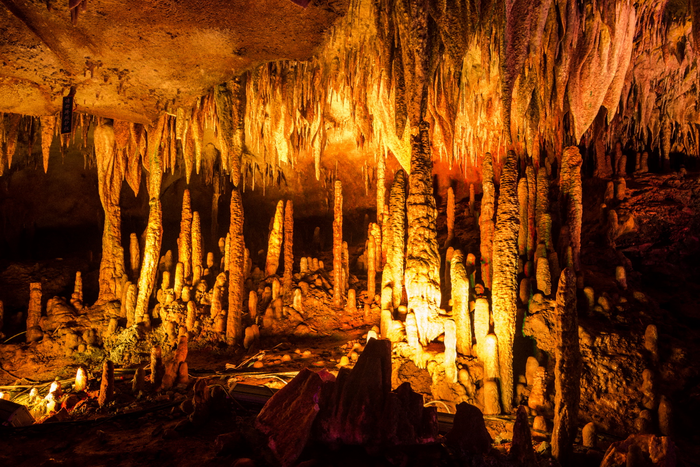Reviewed by Alex SmithNov 25 2021
"China's Venice of the Stone Age": The Liangzhu excavation location in eastern China is one of the most noteworthy pieces of evidence of Chinese civilization. Over 5000 years ago, the city had an intricate water management system.
 Stalagmites in caves located southwest of the excavation site show a climatic cause for the collapse of the ancient Chinese Liangzhu culture. (Image Credit: Haiwei Zhang).
Stalagmites in caves located southwest of the excavation site show a climatic cause for the collapse of the ancient Chinese Liangzhu culture. (Image Credit: Haiwei Zhang).
Heavy flooding activated by anomalously extreme monsoon rains caused an unexpected breakdown, as a team under the guidance of geologist Christoph Spötl illustrates in the journal Science Advances.
In the Yangtze Delta, approximately 160 km southwest of Shanghai, the archeological ruins of Liangzhu City are situated. There, a very advanced culture thrived around 5300 years ago, which is said to be one of the earliest pieces of evidence of vast water culture.
China’s oldest proof of large hydraulic engineering structures emerges from this late Neolithic cultural site. The walled city had an intricate system of dams, navigable canals, and water reservoirs. This system rendered it possible to support extensive agricultural areas all through the year.
In the history of human progress, this is one of the first examples of very developed communities founded on their water infrastructure. Metals, however, were still unfamiliar in this culture. Thousands of intricately crafted jade burial objects were discovered during excavations. Long unexplored and underestimated in its historical importance, the archaeological location is at present viewed as a well-preserved proof of Chinese civilization going back some 5000 years.
UNESCO declared Liangzhu as a World Heritage Site in 2019. Nevertheless, the advanced civilization of this city, which was occupied for nearly 1000 years, came to a sudden halt. Until the present day, it is debated as to what caused it.
A thin layer of clay was found on the preserved ruins, which points to a possible connection between the demise of the advanced civilization and floods of the Yangtze River or floods from the East China Sea. No evidence could be found for human causes such as warlike conflicts. However, no clear conclusions on the cause were possible from the mud layer itself.
Christoph Spötl, Head of the Quaternary Research Group, Department of Geology, University of Innsbruck
Dripstones Store the Answer
Caves and their deposits, such as dripstones, are among the most significant climate records that are present. They enable the reconstruction of climatic environments above the caves up to several 100,000 years into ancient times.
Since it is still unclear what brought on the unexpected downfall of the Liangzhu culture, the researchers searched for appropriate archives in order to explore a probable climatic cause of this downfall. Geologist Haiwei Zhang from Xi'an Jiaotong University in Xi'an, who spent a year at the University of Innsbruck as a visiting scientist in 2017, collected samples of stalagmites from the two caves Jiulong and Shennong, which are situated southwest of the excavation zone.
These caves have been well explored for years. They are located in the same area affected by the Southeast Asian monsoon as the Yangtze delta and their stalagmites provide a precise insight into the time of the collapse of the Liangzhu culture, which, according to archaeological findings, happened about 4300 years ago.
Christoph Spötl, Head of the Quaternary Research Group, Department of Geology, University of Innsbruck
Data from the stalagmites revealed that between 4345 and 4324 years ago, there was a period of very high precipitation. Proof for this was found in the isotope records of carbon, which were calculated at the University of Innsbruck. The precise dating was performed by uranium-thorium analyses at Xi'an Jiaotong University, whose measurement precision is ± 30 years.
This is amazingly precise in light of the temporal dimension. The massive monsoon rains probably led to such severe flooding of the Yangtze and its branches that even the sophisticated dams and canals could no longer withstand these masses of water, destroying Liangzhu City and forcing people to flee.
Christoph Spötl, Head of the Quaternary Research Group, Department of Geology, University of Innsbruck
The highly humid climatic environments continued recurrently for another 300 years, as the geologists illustrate from the cave data.
Journal Reference:
Zhang, H., et al. (2021) Collapse of the Liangzhu and other Neolithic cultures in the lower Yangtze region in response to climate change. Science Advances.